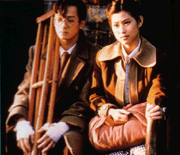A City of Sadness chronicles the lives of the Lin family during the turbulent four years between the Japanese withdrawal from Taiwan (after 51 years of occupation) in 1945, to the secession of Taiwan from mainland China in 1949. The eldest brother, Wen-Heung (Chen Sown-yung), a robust man with crude manners, returns from the war to open a family restaurant called ‘Little Shanghai’ in celebration of Taiwan’s reunification with mainland China. The second brother, Wen-Leung (Jack Gao), became insane during his tour of duty, and is being treated at the local hospital. After Wen-Leung’s recuperation, the lack of prospects in Taiwan and lure of easy money from the Shanghai visitors draw him into the world of organized crime. A third brother, Wen-Sun, sent into combat in the Philippines, is missing in action. The fourth brother, a pensive, shy young man named Wen-Ching (Tony Leung), spared from conscription because of deafness, runs a photography studio. In these uncertain times, even the schools are not immune from the chaos. The school headmaster, Ogawa (Nagatani Sentaro), a man of Japanese heritage, is ordered to repatriate to Japan with his daughter, Shizuko (Nakamura Ikuyo). Wen-Ching’s friend Hinoe (Wu Yifang), a teacher and intellectual, is increasingly seen as an insurrectionist threat by the corrupt mainland officials, and is forced to hide out in the mountains in order to spare his family from political harassment. Meanwhile, Hinoe’s sister, Hinome (Xin Shufen), a nurse, becomes a constant witness to the chaos, as her responsibilities shift from tending to war casualties, to gang-related violence, to military aggression. Hinome is in love with the gentle Wen-Ching, but the country’s instability continues to threaten their happiness. One day, in what has come to be known as the 2/28 Incident, mainland officials violently crack down on the Taiwanese rebels, and thousands of people are imprisoned or killed in the uprising. Wen-Ching is among those detained by the authorities. In a subtly disturbing scene, Wen-Ching nervously paces the crowded prison cell as he awaits his uncertain fate, unable to hear the distant sound of gunfire from the swift execution of convicted dissidents.
Hou Hsiao-hsien creates a thematically complex and visually intoxicating historical account of the birth of the Taiwanese nation in A City of Sadness. Through seamless ellipses, Hou encapsulates the uncertainty and violence of a turbulent period into the graceful narrative account of personal history: the poem written by Shizuko’s brother, presumably killed in the war; a young Wen-Ching imitating the gestures of an opera singer; the Taiwanese rebels mistaking Wen-Ching for a mainlander because of his inability to speak; Wen-Leung’s violent clash with a rival gang. Hou further creates a sense of impotence and cyclicality through recurring imagery that reflects Taiwan’s pattern of occupation and subservience at the governing hands of interfering “outsiders”. The repeated stationary shot of the hospital entrance from takes on several meanings: the admission of wounded soldiers, a shell-shocked Wen Leung, and subsequently, rebels; the birth of a child; Shizuko’s poignant farewell to her childhood friend, Hinome, before evacuating the island. An early scene shows a framed shot of the father seated at a table amid the confusion of preparations for the day’s festivities, as Wen-Heung rationalizes Wen-Ching’s absence from the family gathering. It is a stark contrast to the final shot of the family patriarch and Wen-Leung at the dinner table, as a historical anecdote concludes the film: the loss of mainland China in 1949. Juxtaposed against the understatedly poignant image of the father and son dining in silence, their profound mutual loss is palpable and shattering.
© Acquarello 2000. All rights reserved.
